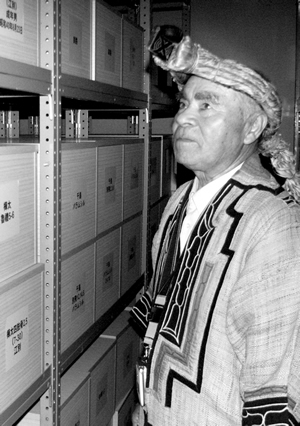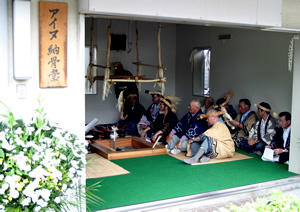 Scholars at Japanese universities
Scholars at Japanese universities
have desecrated Ainu graves and brought the human remains back to their laboratories. In particular, KODAMA Sakuzaemon of Hokkaido Imperial University excavated numerous Ainu graves in Hokkaido, Sakhalin and the Kuril Islands in the 1930’s.
TEXT: Professor Tetsuya UEKI, Tomakomai Komazawa University Department of Intercultural Studies
In 19th century Europe,
scholars were interested in human skulls. They expected the measurements of skulls would clarify differences between human ‘races’. Such research commenced in Japan in the Meiji era.
TEXT: Professor Tetsuya UEKI, Tomakomai Komazawa University Department of Intercultural Studies
 Besides ancestral remains,
Besides ancestral remains,
scholars unearthed many grave goods. Countless artifacts dug up by KODAMA Sakuzaemon, once called the ‘Kodama Collection’ and put on display at Hokkaido University, are now missing.
TEXT: Professor Tetsuya UEKI, Tomakomai Komazawa University Department of Intercultural Studies
It was criminal
to exhume graves although Hokkaido University insisted that they were unowned graves or ancient ruins. Considering that the Ainu used to conduct memorial services for their ancestors in their homes, not at the graves, and that some unearthed bodies were still very fresh, it is incorrect to refer to them as “unowned” or “ruins”.
TEXT: Morihiro ICHIKAWA, Lawyer
 In 2012 Yuri JOHNOGUCHI,
In 2012 Yuri JOHNOGUCHI,
an 81-year-old Ainu woman living in Urakawa, sued the University of Hokkaido to carry out her mother's will, in which she begged Yuri to bring home her ancestors' remains to her Kineusu kotan for reburial 28 years ago. Yuri says, "I can't bear to die leaving them as they are."
TEXT: Yuji SHIMIZU, chairman of the Ethnic Minority Meeting
Why does Hokkaido University
hesitate to return human remains to the kotans? Maybe they are afraid of losing their dignity. Scholars at Japanese universities have desecrated Ainu graves without being noticed. The university fears the past come to light, I guess.
TEXT: Professor emeritus Susumu EMORI, Tohoku Gakuin University
Plans underway
to transfer Ainu ancestral remains from Japanese universities to a memorial facility in Shiraoi still maintain the option for “research”. This must not be allowed without the Ainu’s free, prior, and informed consent, and university’s past responsibility must also be made clear.
TEXT: Yoshihiko TONOHIRA, Priest
In America,
the return of human remains is mandated by federal law (1990) which requires federally funded museums and universities to repatriate human remains to tribes.
TEXT: Toshimi ICHIKAWA, activist
Ainu lived in kotans,
which means villages or tribes. Each kotan was independent and had its own original political, legal and social systems. Further, each kotan had its own cemetery within its territory. Therefore the Ainu are able to pinpoint where their ancestors had been buried.
TEXT: Morihiro ICHIKAWA, Lawyer
Article 12 of the UN Declaration
on the Rights of Indigenous Peoples recognizes indigenous peoples' right to the "repatriation of their human remains." Hokkaido University does not seem to understand it, does it ?
TEXT: Professor emeritus Susumu EMORI, Tohoku Gakuin University